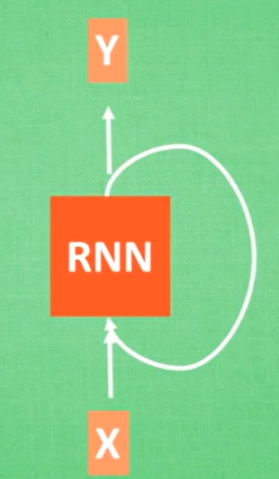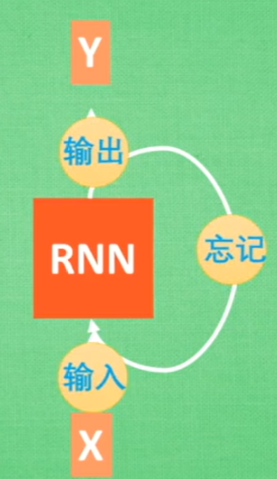一、简介
LSTM(Long short-Term Memory)是一种 RNN 特殊的类型,可以学习长期依赖信息。
LSTM 由Hochreiter & Schmidhuber (1997)提出,并在近期被Alex Graves进行了改良和推广。在很多问题,LSTM 都取得相当巨大的成功,并得到了广泛的使用。

1.与HMM比较
HMM是最早期的序列预测的算法:


“HMM“和”“RNN”的关系就像“桌子”和“板子”,不是一回事,但也不是完全没关系。
在机器学习分类中,“HMM”被划分为“经典机器学习算法”,“RNN”则为“经典的深度学习模型”。
RNN与HMM的本质区别是RNN没有马尔科夫假设,可以考虑很长的历史信息。另外HMM本质是一个概率模型,而RNN不是。
在好多传统领域,经典模型仍然在发挥这作用,我记得周志华的一个PPT曾经讲过,“就算某一天深度学习被淘汰了,经典的机器学习算法也未必会淘汰“”。个人观点,不比纠结于哪个模型更强大,哪个模型可以完全取代谁,每个模型的产生其实都是有历史条件的。经典模型和时髦模型都尤其存在的价值。
——摘抄于知乎
2.RNN的优化
youtube视频讲解:什么是 LSTM RNN 循环神经网络 (深度学习)? What is LSTM in RNN (deep learning)?
如果没有条件观看,我这里简单复述一下视频内容(LSTM和RNN的区别):

学习过程:得到一个误差

通过反向传递,误差每一步都会乘以一个权值。
如果w小于1:误差会越来越小,在接近初始值的时候误差接近于0,这个过程叫做:“梯度消失”。

如果w大于1:误差会越来越大,在接近初始值的时候误差超级大,这个过程叫做:“梯度爆炸”。这也是RNN无法解决的问题。

LSTM就是在RNN的基础上增加了3个控制器:输入、输出、忘记。


将LSTM内部分为主线和分线部分,控制器输入和忘记将分线有效的学习内容加入主线,最后输出。

3.LSTM的应用
1.自动图片标题生成
《显示并告知:一个神经网络标题生成器》,2014
输入一张图片,预测图片内容,再将单词连接成一个完整的句子。

2.文本自动翻译
3.自动手写体生成
4.音乐的生成
5.字母的生成
更多了解参考:《机器学习博士手把手教你入门LSTM》
二、LSTM源码实例
1.入门–天气预测
博文参考:https://www.rs-online.com/designspark/lstm-1-cn
源码:https://github.com/danrustia11/WeatherLSTM
对 台湾宜兰县的每日环境温度 进行lstm训练:
- 读取csv:(2000天+温度记录)
- 数据进行中值滤波和高斯滤波
- 构建LTSM神经网络
- 划分训练集和测试集
- 训练集训练
- 测试集检测
- 可视化查看结果
keras+sklearn学习参考源码:
#
# 博文参考:https://www.rs-online.com/designspark/lstm-1-cn
# 源码参考:https://github.com/danrustia11/WeatherLSTM
# LSTM weather prediction demo
# Written by: Dan R 2020
#
#
# Core Keras libraries
#
from numpy import array
from sklearn.metrics import r2_score # 拟合优度
from sklearn.metrics import mean_squared_error # 均方差
from sklearn.preprocessing import MinMaxScaler
import pandas as pd
import matplotlib.pyplot as plt
import tensorflow as tf # 随机数生成器,结果可重现
from keras.models import Sequential
from keras.layers import Dense
from keras.layers import LSTM # LSTM
from keras.layers import Bidirectional # 双向
#
# For data conditioning
#
from scipy.ndimage import gaussian_filter1d # 数据调节
from scipy.signal import medfilt
#
# Make results reproducible
#
from numpy.random import seed
seed(1)
tf.random.set_seed(1)
#
# Other essential libraries
#
# Make our plot a bit formal
font = {'family': 'Arial',
'weight': 'normal',
'size': 10}
plt.rc('font', **font)
#
# Set input number of timestamps and training days
#
n_timestamp = 10 # 时间戳
train_days = 1500 # number of days to train from 开始的天数
testing_days = 500 # number of days to be predicted 可以预测的天数
n_epochs = 25 # 训练轮数
filter_on = 1 # 激活数据过滤器
#
# Select model type 选择型号类型
# 1: Single cell 单格
# 2: Stacked 堆叠
# 3: Bidirectional 双向
#
model_type = 2
#-----------------------------------------
# 数据集
#-----------------------------------------
# 台湾环境保护局提供的台湾宜兰县的每日环境温度
# url = 'https://raw.githubusercontent.com/danrustia11/WeatherLSTM/master/data/weather_temperature_yilan.csv'
url = "D:/myworkspace/dataset/WeatherLSTM-master/data/weather_temperature_yilan.csv"
dataset = pd.read_csv(url)
if filter_on == 1: # 数据集过滤
dataset['Temperature'] = medfilt(dataset['Temperature'], 3) # 中值过滤
dataset['Temperature'] = gaussian_filter1d(
dataset['Temperature'], 1.2) # 高斯过滤
#
# Set number of training and testing data 设置训练和测试数据集
#
train_set = dataset[0:train_days].reset_index(drop=True)
test_set = dataset[train_days: train_days+testing_days].reset_index(drop=True)
training_set = train_set.iloc[:, 1:2].values
testing_set = test_set.iloc[:, 1:2].values
#-----------------------------------------
# 数据集完
#-----------------------------------------
#
# Normalize data first
#
sc = MinMaxScaler(feature_range=(0, 1)) # 将数据标准化,范围是0到1
training_set_scaled = sc.fit_transform(training_set)
testing_set_scaled = sc.fit_transform(testing_set)
#
# Split data into n_timestamp
#
def data_split(sequence, n_timestamp):
X = []
y = []
for i in range(len(sequence)):
end_ix = i + n_timestamp
if end_ix > len(sequence)-1:
break
# i to end_ix as input
# end_ix as target output
seq_x, seq_y = sequence[i:end_ix], sequence[end_ix]
X.append(seq_x)
y.append(seq_y)
return array(X), array(y)
X_train, y_train = data_split(training_set_scaled, n_timestamp)
X_train = X_train.reshape(X_train.shape[0], X_train.shape[1], 1)
X_test, y_test = data_split(testing_set_scaled, n_timestamp)
X_test = X_test.reshape(X_test.shape[0], X_test.shape[1], 1)
# 使用Keras建构LSTM模型
if model_type == 1:
# Single cell LSTM
model = Sequential()
model.add(LSTM(units=50, activation='relu',
input_shape=(X_train.shape[1], 1)))
model.add(Dense(units=1))
if model_type == 2:
# Stacked LSTM
model = Sequential()
model.add(LSTM(50, activation='relu', return_sequences=True,
input_shape=(X_train.shape[1], 1)))
model.add(LSTM(50, activation='relu'))
model.add(Dense(1))
if model_type == 3:
# Bidirectional LSTM
model = Sequential()
model.add(Bidirectional(LSTM(50, activation='relu'),
input_shape=(X_train.shape[1], 1)))
model.add(Dense(1))
#
# Start training 模型训练,batch_size越大越精准,训练消耗越大
#
model.compile(optimizer='adam', loss='mean_squared_error')
history = model.fit(X_train, y_train, epochs=n_epochs, batch_size=32)
loss = history.history['loss']
epochs = range(len(loss))
#
# Get predicted data 测试集预测
#
y_predicted = model.predict(X_test)
#
# 'De-normalize' the data 正规化将数据还原
#
y_predicted_descaled = sc.inverse_transform(y_predicted)
y_train_descaled = sc.inverse_transform(y_train)
y_test_descaled = sc.inverse_transform(y_test)
y_pred = y_predicted.ravel()
y_pred = [round(yx, 2) for yx in y_pred]
y_tested = y_test.ravel()
#
# Show results 显示预测结果,包括原始数据、n个预测天数和前75天
#
plt.figure(figsize=(8, 7))
plt.subplot(3, 1, 1)
plt.plot(dataset['Temperature'], color='black',
linewidth=1, label='True value')
plt.ylabel("Temperature")
plt.xlabel("Day")
plt.title("All data")
plt.subplot(3, 2, 3)
plt.plot(y_test_descaled, color='black', linewidth=1, label='True value')
plt.plot(y_predicted_descaled, color='red', linewidth=1, label='Predicted')
plt.legend(frameon=False)
plt.ylabel("Temperature")
plt.xlabel("Day")
plt.title("Predicted data (n days)")
plt.subplot(3, 2, 4)
plt.plot(y_test_descaled[0:75], color='black', linewidth=1, label='True value')
plt.plot(y_predicted_descaled[0:75], color='red', label='Predicted')
plt.legend(frameon=False)
plt.ylabel("Temperature")
plt.xlabel("Day")
plt.title("Predicted data (first 75 days)")
plt.subplot(3, 3, 7)
plt.plot(epochs, loss, color='black')
plt.ylabel("Loss (MSE)")
plt.xlabel("Epoch")
plt.title("Training curve")
plt.subplot(3, 3, 8)
plt.plot(y_test_descaled-y_predicted_descaled, color='black')
plt.ylabel("Residual")
plt.xlabel("Day")
plt.title("Residual plot")
plt.subplot(3, 3, 9)
plt.scatter(y_predicted_descaled, y_test_descaled, s=2, color='black')
plt.ylabel("Y true")
plt.xlabel("Y predicted")
plt.title("Scatter plot")
plt.subplots_adjust(hspace=0.5, wspace=0.3)
plt.show()
mse = mean_squared_error(y_test_descaled, y_predicted_descaled) # 均方误差
r2 = r2_score(y_test_descaled, y_predicted_descaled) # 决定系数(拟合优度)接近1越好
print("mse=" + str(round(mse, 2)))
print("r2=" + str(round(r2, 2)))
2.结果

图一:全部数据(x轴:2000+天数,y轴:温度)
图二:n天温度预测结果
图三:前70天预测结果,可以看见LSTM在不断学习优化
图4,5,6:训练评价因素可视化
3.评价标准

mse均方差(mean-squared-error)

R2 决定系数(拟合优度)

模型越好:r2→1
模型越差:r2→0
更多评价标准参考:学习笔记2:scikit-learn中使用r2_score评价回归模型
同理,在载入自己的数据集时,修改数据集读取模块即可。
